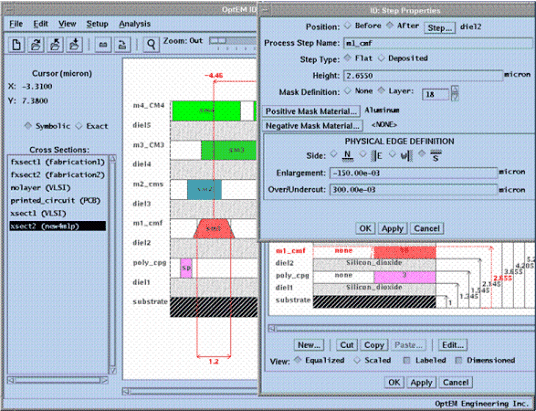OptEM ID – Pre-layout Interconnect Design and Parametric Analysis Software
OptEM Interconnect Designer
OptEM Interconnect Designer
OptEM Interconnect Designer (OptEM ID) is a pre-layout interconnect design and parametric analysis software tool used to investigate interconnect signal integrity, perform "what-if" parametric simulations, analyze current density hot spots, and determine interconnect design rules.

Product Description
The combination of shrinking feature size, increased packing density, increased interconnect length, and faster clock rates have caused interconnect delays to dominate and 2nd order effects such as cross-coupling to become significant. Engineers facing these new interconnect challenges need CAE software tools that can quickly and easily characterize the electrical performance of interconnects. OptEM ID's ability to perform "what-if" analyses, generate statistical information and set up interconnect design rules for today's high-performance digital and analog systems allows engineers to locate design errors, make changes and improve system performance.
Variables and Parameters
OptEM ID is a parametric design and analysis tool that investigates how electrical characteristics of an interconnect structure change as input parameters change. Often, in the final manufactured product, many design parameters differ from their original specifications. Variables representing frequency, material characteristics, cross section geometries and other parameters are defined and analyzed over a range of values. As a result, OptEM ID allows you to investigate the effects that these parametric changes have on the electrical performance of the interconnect system.
Cross Section Editor
Within the cross section editor variables are defined for all geometric parameters of a cross section including conductor thickness, width and height, dielectric thickness, and frequency and material characteristics. Then each cross section is analyzed parametrically and statistically. Using frequency-dependent current distribution analysis, OptEM ID calculates interconnect circuit models with extreme accuracy. Results include parameter dependent output properties like inductance and resistance that require skin effect calculations for accuracy. Changes of inductance and resistance due to the skin effect, if not planned for, may cause the device to become inoperable.
Interconnect Analyses
Using parametric, statistical and circuit analyses, OptEM ID is able to predict resistance, capacitance, inductance, crosstalk and other parasitic effects. Performing a parametric analysis allows you to see how different parameters affect each other. The Monte Carlo statistical analysis offers an efficient method of including manufacturing tolerances and statistical distributions in the analysis when calculating the electrical characteristics of an interconnect. For the frequency-domain, OptEM ID builds an S-parameter model of the network. And for time-domain, OptEM ID calculates and plots signal integrity effects in the circuits.
The analyses provided by OptEM ID generate a variety of reports, models, and graphical plots. Reports can include R, L, C and G matrices, time delay information, characteristic impedance, attenuation, and more. Both SDF and SPICE interconnect models are available for subsequent circuit analysis. OptEM ID graphical results include 2D and 3D parametric plots, Monte Carlo stair-step and bar charts, and Cartesian plots for signal integrity results from time and frequency domain analyses.

Features & Benefits
Features
- ability to define design parameters and assign manufacturing tolerances
- parametric analysis
- statistical analysis
- time-domain analysis
- frequency-domain analysis
- cross section editor that models multi-dielectrics and multi-conductors deposited on conformal or flat layers
- cross section circuit definition
- batch analysis
Benefits
- generate design rules for cross sections
- study the effects of variations of parameters
- study the effect of manufacturing tolerances
- generate complex multiport S-parameters
- transient simulation of reflection, crosstalk, and ground bounce
- differential source/return pairs, even/odd mode impedance, and reassignment of ground within the cross section
- allows concurrent modeling and analysis
